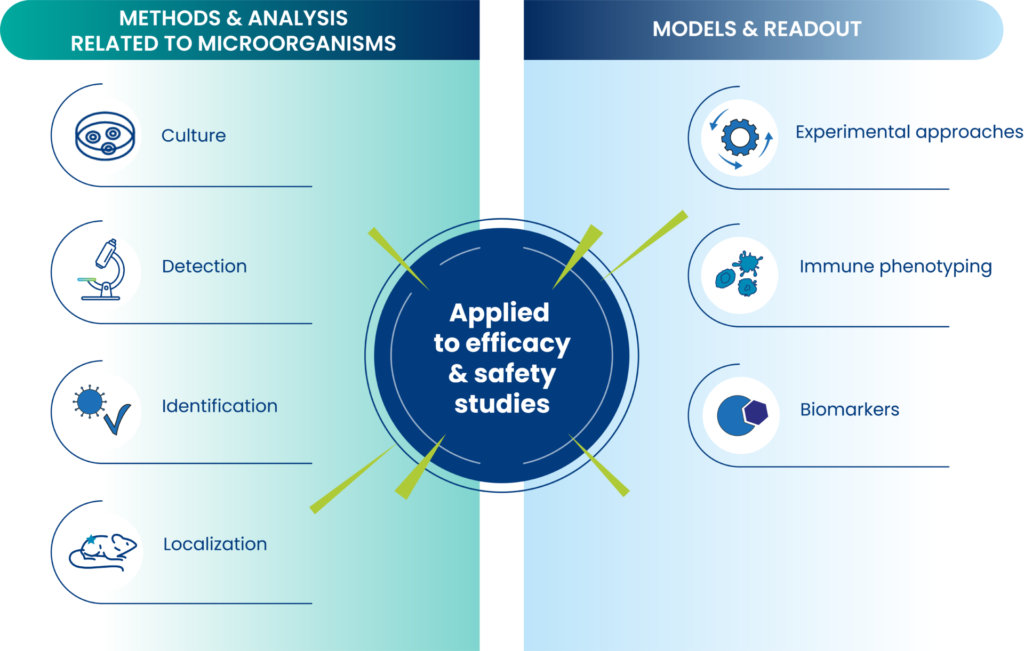


Use of dPCR as a valuable method to analyse microbiome
Digital PCR (dPCR) is part of the new wave of advanced technologies that have revolutionized research based on microorganisms. Indeed, dPCR facilitates rapid responses, offers enhanced sensitivity, and provides precise quantification of microorganisms, leading to advancements in various fields including drug development, cosmetics, and nutrition.
Oncodesign Services has developed a comprehensive suite of services that combines bioanalytical capabilities with microbiome expertise. This approach is designed to demonstrate the health benefits, assess the safety, and decipher the mechanisms of action of microbiome-based products.
Microbial detection and microbiome analysis by dPCR
Digital PCR provides a highly accurate method for microbiome analysis, enabling detailed studies of microbial composition and population dynamics. Discover here a summary of various microbiome-related analyses that can be conducted using this technology.
Identification and quantification of living-microorganisms
dPCR can be used to accurately quantify e.g. bacteria, viruses, and fungi in samples . This quantification doesn’t need a standard curve, which is particularly useful for measuring changes in microbial density under different experimental or environmental conditions. In case of living microorganisms, dPCR could be coupled with PMA (propidium monoazide).
What is digital PCR ?
Digital PCR is an evolution of traditional PCR (polymerase chain reaction) that provides more accurate and sensitive quantification of nucleic acids. Unlike quantitative real-time PCR (qPCR), which estimates the amount of nucleic acid by measuring the fluorescence signal intensity at each cycle and extrapolating this quantity during the initial phases of amplification, dPCR divides the sample into many small, independent compartments (often thousands), conducts a PCR reaction in each compartment, and then counts the number of positive compartments to deduce the exact concentration of the target in the original sample.

Identifying of living microorganisms with dPCR could be coupled with PMA
Analysis of community diversity and structure
dPCR examines the specific composition of microbial communities by detecting and quantifying targeted species or strains.
Monitoring Changes in Population Composition
Changes in environmental conditions can lead to shifts in the composition of a population, affecting both the species present and their proportions, as well as the genomes of individual species. To effectively monitor these changes, analysis must be swift and requires precise quantification of the population’s composition and structure, what dPCR allows.
Detection of Low-Abundance Microorganisms
Due to its high sensitivity, dPCR is capable of detecting and quantifying microbes present in very small quantities.
Mutation Analysis and Treatment Resistance
dPCR facilitates the study of the distribution and abundance of antibiotic resistance genes or virulence factors within microbial populations, essential for understanding the mechanisms of resistance and the spread of harmful traits. It’s particularly useful in the treatment of diseases such as cancer and bacterial infections.
Genetic and Biodiversity Studies
dPCR can be used to quantify gene expression in microorganisms, an important step for deciphering the regulation of gene expression in response to environmental conditions and other stimuli.
Adapted for a Wide Range of Sample Types
In the case of microbiome-research, dPCR analysis can be carried out on large variety of samples, coming from clinical trials (e.g. feces, skin swabs, blood) or animal model studies (collection of specific tissues or fluids).
The samples are chemically treated upstream before extraction and passage through dPCR.
Oncodesign Services supports your Microbiome studies with state-of-the-art bioanalytical capabilities
Oncodesign Services has developed translational skills and experience in this growing field to serve the evolving needs of R&D programs using microbiome insights in oncology, immuno-oncology, inflammatory diseases, infectious diseases, dermocosmetics and nutrition.
Our facilities, environment and collaborations/networks allow us to work with preclinical and clinical samples (GLP/GcLP compliant environment in bioanalysis) and to manipulate microorganisms (BSL2, BSL3 and GMO2 compliant laboratories).
We provide different methods for culturing, detecting, quantifying, identifying and localizing bacteria such as PMA-dPCR, CFUs, mass spectrometry, bioluminescence, in simple or complex samples. In addition, a continuum of assays allows us to evaluate the impact of microbes or derived products ondisease and/or immune system.

Examples of dPCR testing applied to microbiome research at different stages of drug development:
- Evaluate the effectiveness of a treatment targeting specific strains on the skin microbiota
- Check the viability of specific microorganisms following crossing of digestive tract.
- Determine the bacterial, viral or fungal load for checking colonization of specific organs, absence of leakage to off target sites.



